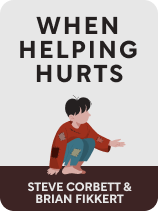

This article is an excerpt from the Shortform book guide to "When Helping Hurts" by Steve Corbett and Brian Fikkert. Shortform has the world's best summaries and analyses of books you should be reading.
Like this article? Sign up for a free trial here.
What is an asset-based community development approach? Why should you focus on assets when reducing poverty?
In When Helping Hurts, Steve Corbett and Brian Fikkert say that sometimes outside resources are not the solution to reducing poverty in communities. Instead, you should first look at what the community already has and work from there.
Below we’ll look at how assets can change how you approach poverty alleviation.
Stop Focusing on Problems and Providing Outside Resources
Beyond providing the wrong type of aid, the other problematic approach to poverty alleviation that Corbett and Fikkert observe is when aid providers start by assessing the needs of the poor community and pairing them with outside resources to develop solutions. This approach often stems from a paternalistic superiority complex, as it comes down to telling the poor: “Tell us your problems, and we’ll provide a solution.”
This approach also implicitly assumes that the poor community’s problems cannot be solved without outside resources and focuses outside attention solely on their problems. As such, it reinforces their sense of shame, inferiority, and powerlessness, making their poverty worse.
To avoid these problems, Corbett and Fikkert advise taking an asset-based community development approach before their needs, as we’ll discuss next.
The Weakness-Based Approach in Business
Just as Corbett and Fikkert critique the practice of focusing first on problems when trying to help the poor, business experts at the Gallup Press argue that the common practice of focusing on employees’ weaknesses when trying to improve their performance is fundamentally flawed.
They observe that there is a popular belief that anyone can do or become proficient in just about anything if they identify and fix the weaknesses that are holding them back from success. They point out a number of problems with this view:
1. If everyone has unlimited potential, then nobody really has a unique identity. As such, the practice of trying to help people advance by identifying and fixing all their weaknesses is ultimately dehumanizing.
2. The idea that people can fix their weaknesses with hard work and perseverance conflicts with the reality that many people struggle for years to overcome certain weaknesses and never seem to make any headway. Furthermore, this idea implies that when this happens, it must be their fault for not trying hard enough, which is demoralizing to them.
3. Focusing exclusively on correcting your weaknesses leads you to neglect using or developing your strengths, which is, at best, an inefficient use of time and effort.
These observations from the realm of business reinforce Corbett and Fikkert’s assertions and provide additional insight into why the needs-based approach tends to be demoralizing, dehumanizing, and generally counterproductive—both in poverty alleviation and employee development.
Assessing Assets Instead of Needs
Corbett and Fikkert recommend an approach called asset-based community development (ABCD). This approach focuses on the poor’s assets, including individuals’ unique skills and talents, as well as the community’s existing resources.
(Shortform note: ABCD approach was originally developed by an urban research center at Northwestern University when they recognized a gap in their researchers’ approach to studying neighborhoods: Research consistently identified community members’ needs and problems but not their capacities, strengths, and achievements. This realization inspired them to begin a new four-year effort to study neighborhoods’ assets, and their research later became a global movement.)
Corbett and Fikkert discuss a number of advantages of the asset-based approach. First, whereas a needs-based approach emphasizes what’s “wrong,” an asset-based approach emphasizes what’s “right,” which is more encouraging for all involved.
Second, an asset-based approach focuses on local resources first, thereby empowering the community and reducing the risk of developing dependence. Only when the community’s assets aren’t sufficient do outsiders offer additional resources.
Finally, using an asset-based approach can help the non-poor overcome feelings of superiority. This is because it emphasizes everything the poor have to offer, which combats the tendency to see them as helpless people.
Focusing on the Positive
We could generalize the importance of assessing assets before needs as focusing on the positive to make changes for the better. Whereas Corbett and Fikkert present this as a strategic principle for poverty intervention, others have advocated it as a way to succeed in business or overcome obstacles in life. Since climbing out of poverty typically involves career development and overcoming a variety of obstacles, these other sources provide additional insight that’s relevant to poverty alleviation.
Arguably the first notable proponent of focusing on the positive side was Norman Vincent Peale, who wrote The Power of Positive Thinking. Like Corbett and Fikkert, Peale approached the subject from a Christian perspective. He argued that you can overcome any difficulty in life if you just believe that you can, pray for God’s assistance, and don’t let negative thoughts discourage your belief.
More recently, Shawn Achor presented a similar argument from a purely secular perspective in The Happiness Advantage. Achor asserts that a positive mindset enhances your productivity, enabling you to succeed in your endeavors. As such, Peale and Achor agree that cultivating a positive mindset leads to success. The difference is that Peale ultimately attributes your success to divine assistance, while Achor attributes it to your own efforts.
Finally, in Strengths Finder 2.0, Tom Rath argues that the best way to advance your career is to focus on cultivating your strengths, rather than on fixing your weaknesses. He asserts that it’s just not possible to fix all your weaknesses. And even if it was, it would be a wasteful use of resources: You can spend a lot of time and energy improving your abilities in an area of weakness, but chances are you’ll still only end up with average ability in that area. But if you spend the same amount of time and energy honing an ability that comes naturally to you, you’ll end up far above average.

———End of Preview———
Like what you just read? Read the rest of the world's best book summary and analysis of Steve Corbett and Brian Fikkert's "When Helping Hurts" at Shortform.
Here's what you'll find in our full When Helping Hurts summary:
- How many Christian church missions actually do more harm than good
- A look into the true nature and causes of poverty
- Suggestions for how to help the poor more effectively






